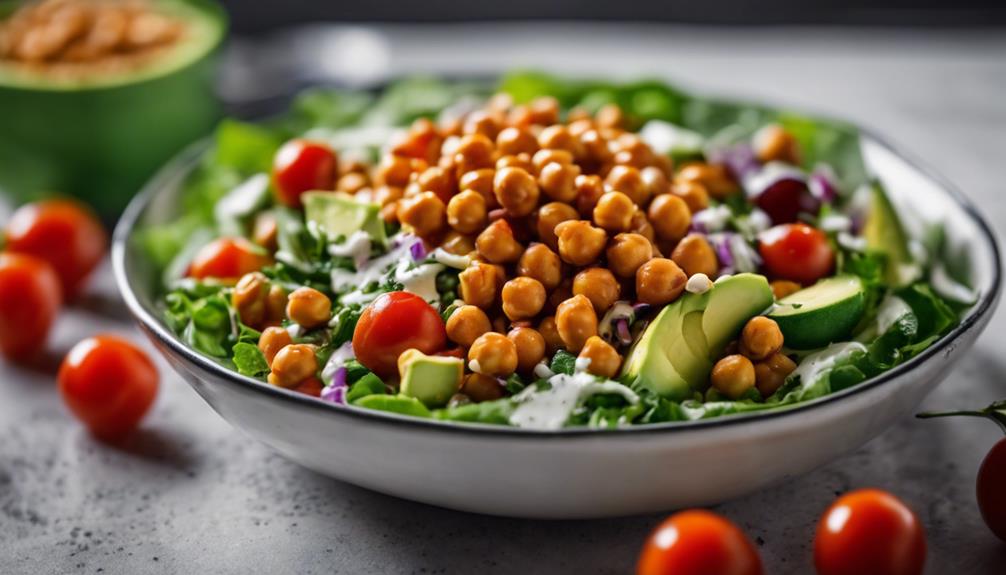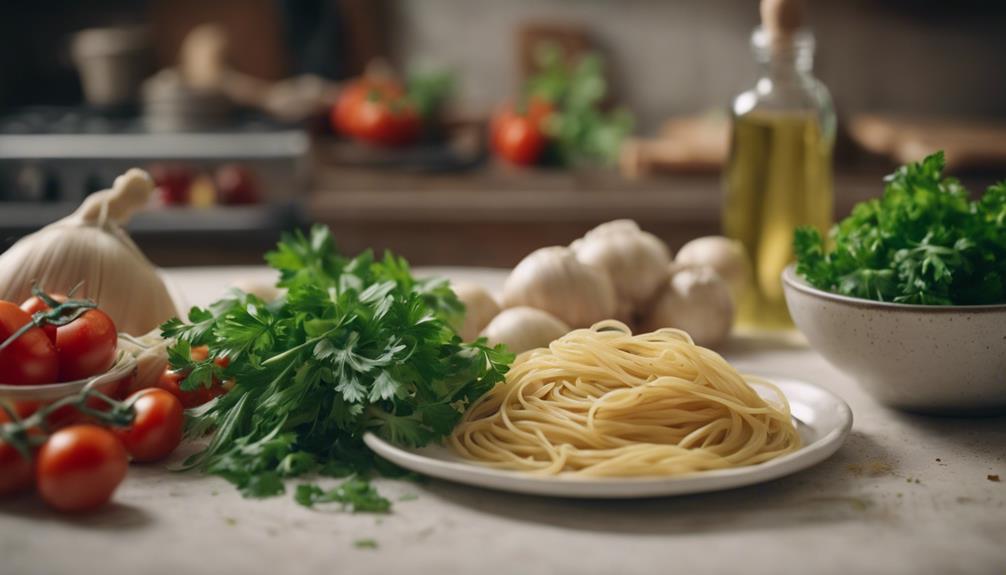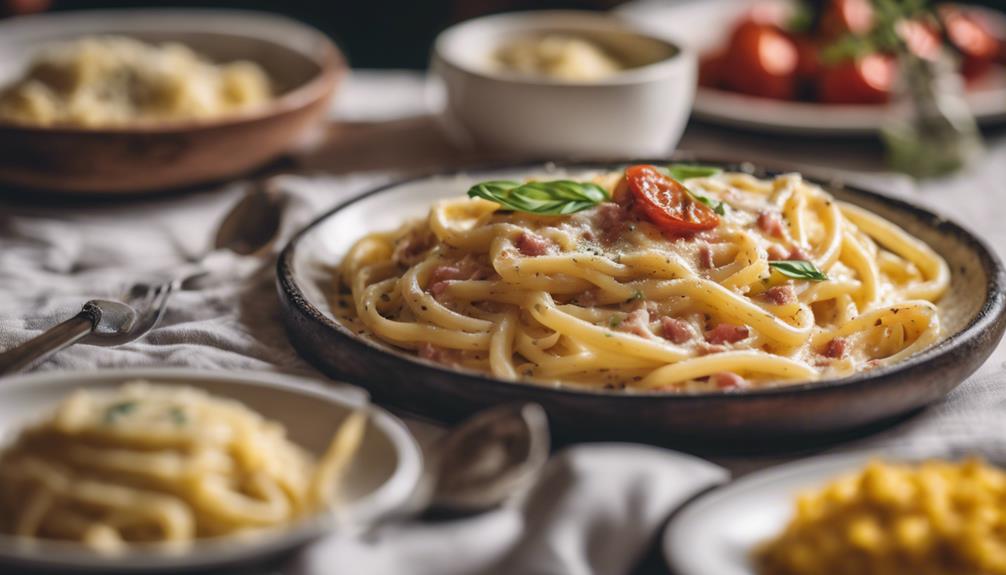Experience the rich and delicious flavors of Roasted Red Pepper Rose Pasta, an exquisite Italian dish that features a creamy combination of roasted red peppers, garlic, basil, and cream. This dish offers a luxurious creaminess and savory notes, creating a tasteful journey that embodies sophistication and charm on your taste buds. The harmonious blend of ingredients in this enchanting dining experience is sure to captivate your senses with each delightful bite, promising an extraordinary dining experience that will redefine your expectations of Italian cuisine.
Key Takeaways
- Creamy sauce blending roasted red peppers, cream, and garlic for a rich flavor profile.
- Versatile dish suitable for weeknight meals or special occasions.
- Easy preparation with simple ingredients for a quick yet elegant meal.
- Pair with pasta of choice for a satisfying Italian dining experience.
- Offers a velvety texture and savory sweetness that delights the taste buds.
Ingredients for Roasted Red Pepper Pasta
To make Roasted Red Pepper Pasta, gather fresh roasted red peppers, cream, garlic, and basil. These ingredients come together to create a luscious and indulgent sauce that coats your pasta perfectly. The roasted red peppers provide a smoky sweetness, while the cream adds richness and depth to the dish. Garlic brings a delightful pungency, enhancing the overall flavor profile. Seasoning with basil and a touch of salt elevates the taste to a whole new level.
Once all the components are assembled, they're blended until smooth, resulting in a velvety texture that clings to the pasta, ensuring each bite is bursting with flavor.
This creamy and vibrant sauce pairs exceptionally well with grilled chicken, adding a protein element that makes the dish even more satisfying. Roasted red pepper pasta offers a comforting and delicious meal option that's sure to please your taste buds.
How to Roast Red Peppers
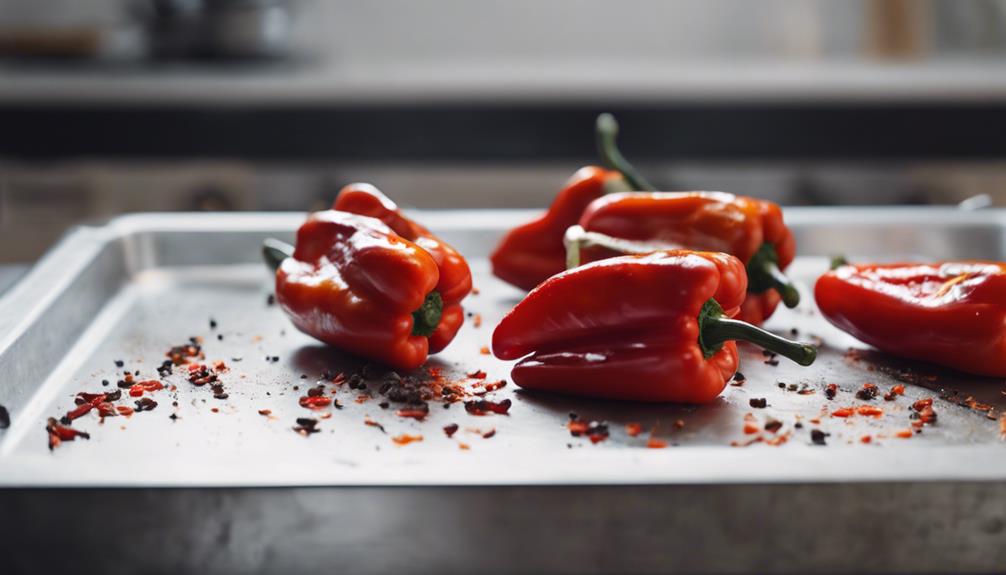
Begin by preheating your oven to 450°F for roasting red peppers. Place the whole peppers on a baking sheet and let them roast for about 20-30 minutes until the skins are blackened.
After roasting, transfer the peppers to a covered container to allow them to steam, making it easier to peel off the skin. The roasting process not only helps in peeling but also enhances the sweetness and flavor of the peppers, making them ideal for pasta sauces.
The roasted red peppers will add a delightful smoky and slightly charred taste to your dishes, elevating the overall flavor profile. Once peeled, remove the seeds and stems, and your roasted red peppers are ready to be used in various recipes like pasta, salads, sandwiches, or dips.
Embrace the rich taste of roasted red peppers to take your culinary creations to the next level.
Making the Creamy Sauce

Consider blending jarred roasted red peppers with heavy cream and dried basil to create a luscious creamy sauce for your pasta.
This customizable sauce is a quick and versatile option for enhancing the flavors of your Italian dish. By combining the rich flavors of the jarred peppers with the velvety texture of heavy cream and the aromatic touch of dried basil, you can achieve a delightful and flavorful sauce that complements a variety of pasta types.
This sauce can be easily adjusted to suit your taste preferences, and it can be doubled or tripled to accommodate larger gatherings. In just about 25 minutes, you can have a creamy and flavorful sauce ready to elevate your meal.
To enhance the dish further, consider sprinkling grated parmesan cheese and fresh basil over the pasta. Not only is this sauce perfect for pasta, but it can also serve as a delicious cream sauce for fish or a dip for proteins, offering a rich and luxurious experience.
Choosing the Right Pasta
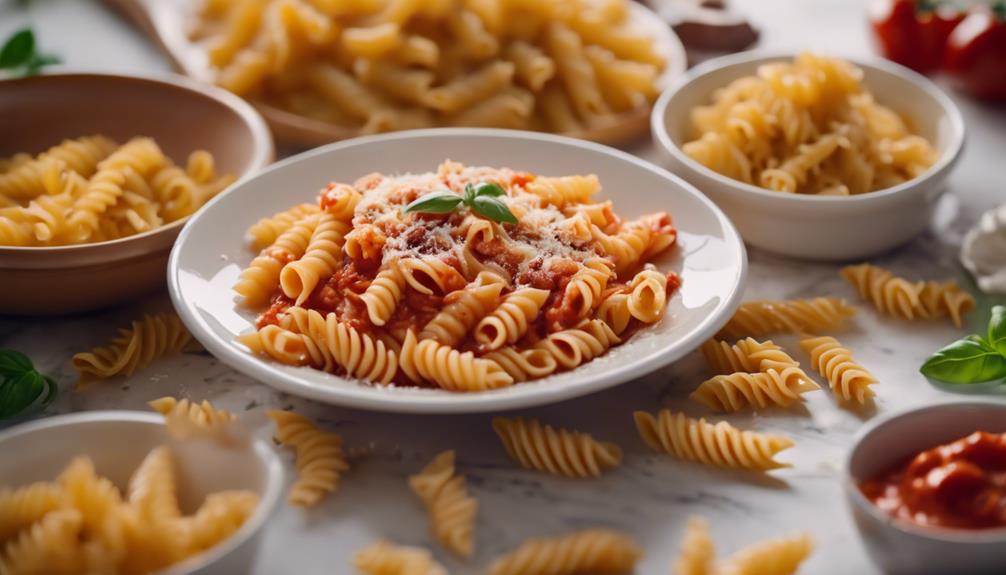
When selecting the right pasta for your Roasted Red Pepper Rose Pasta, consider the pasta shape guide to guarantee a suitable sauce pairing.
Understanding the cooking time tips can help you achieve the perfect al dente texture for your dish.
These points will direct you in choosing the ideal pasta to elevate the flavors of your creamy red pepper sauce.
Pasta Shape Guide
Selecting the appropriate pasta shape is vital for enhancing the flavor and texture of your Roasted Red Pepper Rose Pasta dish. When preparing this dish with red pepper pasta sauce, rigatoni pasta stands out as a top choice due to its ability to capture and hold the sauce within its tube-like structure.
However, other pasta shapes like penne, fusilli, or fettuccine can also be utilized to create a delightful variation. The choice of pasta shape plays an important role in determining the sauce absorption and pasta texture, ultimately influencing the overall dining experience.
The right pasta shape not only ensures that the sauce coats the pasta evenly but also contributes to the visual presentation of the dish. Therefore, consider the pasta shape carefully to complement the flavors and aesthetics of your Roasted Red Pepper Rose Pasta, creating a harmonious blend of taste and visual appeal.
Cooking Time Tips
For best results in cooking your Roasted Red Pepper Rose Pasta, make sure to pay attention to the cooking time of the pasta to achieve the ideal texture and consistency.
When preparing this creamy red pepper pasta, opting for rigatoni pasta is recommended as its ridges help capture the rich sauce, providing a satisfying bite in every forkful.
To guarantee the pasta is cooked to perfection, aim for al dente, where it's firm yet tender to the bite, enhancing the overall dining experience.
Consider using Spanish Hojiblanca olive oil to elevate the flavors of the sauce, adding a delightful Mediterranean touch to the dish.
Whether you roast fresh red peppers for a homemade touch or use jarred peppers for convenience and a hint of smoky taste, the choice is yours.
Additionally, experimenting with different pasta shapes can help you discover the perfect match that complements the creamy roasted red pepper sauce, creating a harmonious blend of flavors and textures in every mouthful.
Serving Suggestions
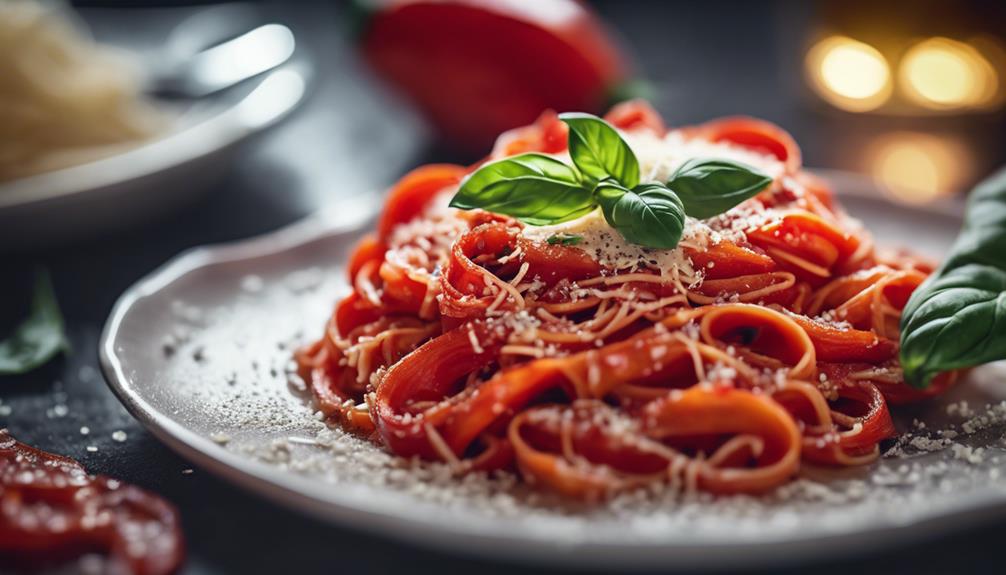
When it comes to serving the Roasted Red Pepper Rose Pasta, let's start by discussing the POINTS.
These include Presentation Tips, Pairing Options, and Garnish Ideas to elevate your dining experience.
Presentation Tips
Enhance the visual appeal of your Roasted Red Pepper Rose Pasta by garnishing it with fresh basil leaves for a burst of color and flavor.
When serving this creamy pasta dish, opt for a shallow bowl to highlight the vibrant red pepper sauce that coats the noodles.
To elevate the dish further, sprinkle a generous amount of freshly grated Parmesan cheese on top, enhancing the creamy texture and adding a savory note.
For a complete meal experience, consider pairing the Roasted Red Pepper Rose Pasta with a side of garlic bread or a simple green salad to complement the flavors.
Additionally, for those seeking a bit of heat, offer crushed red pepper flakes on the side to provide a spicy kick to the dish.
Pairing Options
Consider enhancing your roasted red pepper rose pasta by pairing it with various side dishes and protein options to create a well-rounded and satisfying meal experience. Start by serving a fresh side salad alongside the creamy roasted red pepper pasta to balance out the flavors and textures.
For a protein boost, consider adding grilled chicken or shrimp to the dish, elevating it into a hearty and fulfilling meal. Accompany the pasta with a slice of crusty bread to soak up the delicious sauce and complete the dining experience.
To further enhance the flavors of the dish, sprinkle grated Parmesan cheese on top of the pasta, adding a rich and savory element to each bite.
For a delightful pairing, serve the roasted red pepper pasta with a glass of white wine, which complements the creamy and flavorful notes of the dish. By incorporating these pairing options, you can create a delicious and well-rounded meal that's sure to satisfy your taste buds.
Garnish Ideas
Fresh basil leaves can provide a vibrant and invigorating garnish for your Roasted Red Pepper Rose Pasta. The aromatic herb adds a burst of freshness that complements the creamy texture of the dish.
Consider enhancing the umami flavor of the pasta by sprinkling a generous amount of grated Parmesan cheese on top. This classic Italian touch brings richness and depth to each bite.
For those who enjoy a bit of heat, a pinch of red pepper flakes or a drizzle of chili oil can elevate the dish with a subtle kick.
Toasted pine nuts or walnuts offer a delightful crunch and nutty flavor that pairs well with the roasted peppers and cream sauce.
To finish off your plate, a swirl of high-quality extra virgin olive oil not only enhances the overall taste but also provides a luxurious sheen to your plant-based masterpiece.
Experiment with these garnish ideas to create a visually appealing and flavorful experience with your Roasted Red Pepper Rose Pasta.
Full Recipe & Video Demo
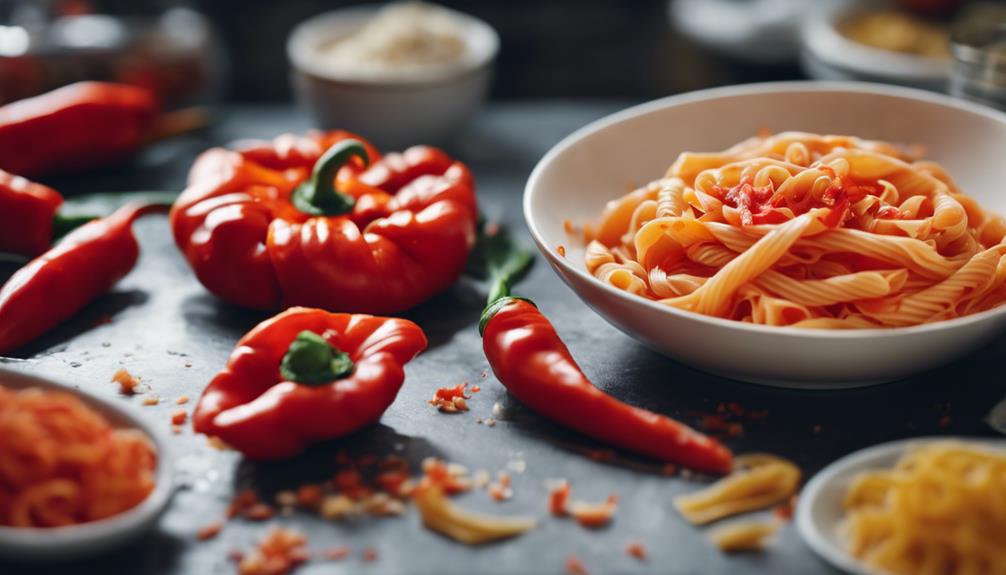
Explore the step-by-step instructions and visual guidance for preparing the Roasted Red Pepper Rose Pasta by watching the full recipe video demonstration.
This creamy and flavorful Italian dish features a rich sauce made with roasted red peppers, cream, garlic, and a blend of seasonings, resulting in a delicious and aromatic flavor profile.
The versatility of the sauce allows it to complement various pasta shapes like rigatoni or fettuccine, offering a satisfying meal option for any occasion.
With its quick preparation time and simple ingredients, this recipe is ideal for both weeknight dinners and special gatherings.
The Roasted Red Pepper Rose Pasta presents a unique twist on traditional pasta dishes, bringing an element of elegance and sophistication to your table.
Storage and Reheating Tips
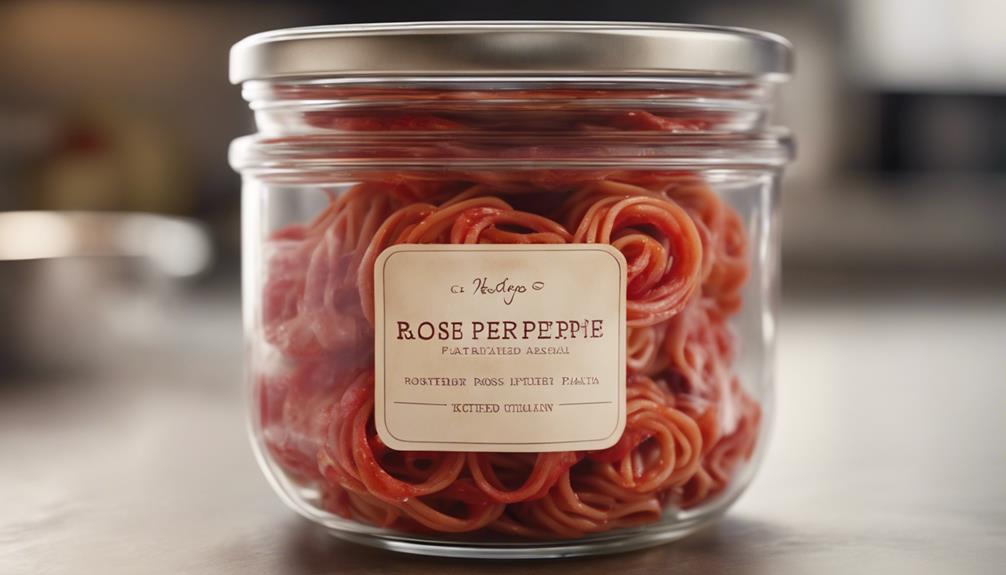
When storing leftover roasted red pepper rose pasta, remember to place it in an airtight container in the refrigerator to maintain its freshness for up to 3-4 days. This guarantees that the flavors remain intact and the pasta stays delicious.
To reheat the dish, transfer it to a microwave-safe dish with a splash of water, cover it loosely, and heat in 30-second intervals until warmed through. Another method for reheating involves using the stovetop; add a bit of olive oil or broth to prevent sticking and gently heat until warmed. Remember to stir the pasta occasionally during reheating to ensure uniform heating.
Overheating the pasta should be avoided as it can lead to a mushy texture and compromise the creaminess of the dish. By following these storage and reheating tips, you can enjoy your jarred roasted red pepper pasta for several days while maintaining its delightful flavors and creamy consistency.
More Pasta Recipe Ideas
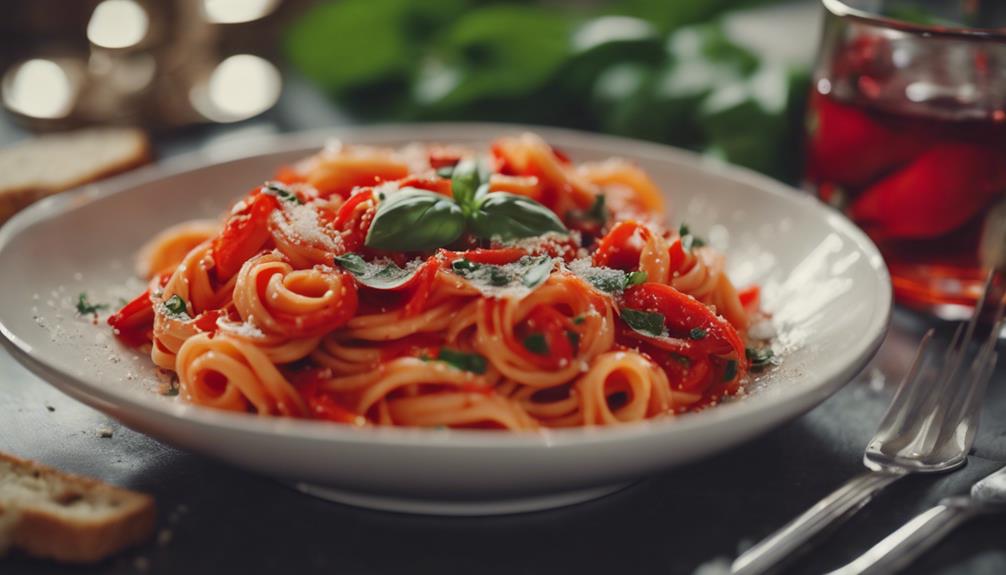
For a delightful culinary adventure, consider trying out these additional pasta recipes that promise to tantalize your taste buds and expand your cooking repertoire.
One delectable option is a Roasted Red Pepper Pasta, a creamy and flavorful Italian dish that captures the essence of savory goodness. This recipe features a velvety sauce infused with the rich flavors of roasted red peppers, garlic, and olive oil. The combination of these ingredients creates a harmonious blend of creamy and savory notes that will leave you craving more.
The Roasted Red Pepper Pasta offers a unique twist on traditional pasta recipes, providing a burst of flavor that's both satisfying and comforting. The creamy texture of the sauce, coupled with the sweetness of the roasted red peppers, creates a truly indulgent experience for your taste buds.
Whether you're a pasta enthusiast or simply looking to add a new savory dish to your menu, this flavorful Roasted Red Pepper Pasta is sure to impress with its richness and depth of flavor.
Frequently Asked Questions
What Is Red Pepper Sauce Made Of?
Red pepper sauce is made of roasted red peppers, garlic, cream, and seasonings like salt, pepper, and basil. You can also add butter for richness and customize it with spices. It's versatile and delicious.
Is Red Bell Pepper Good in Spaghetti Sauce?
Yes, red bell peppers are fantastic in spaghetti sauce. They bring sweetness and depth to the dish, enhancing both the flavor and visual appeal. Roasting them intensifies their taste, making your sauce rich and flavorful.
How Long Does It Take to Roast Red Pepper?
Roasting a red pepper usually takes about 25-30 minutes in a preheated 450°F oven. You'll want to roast it until the skin is blackened and blistered for easy peeling. Allow it to steam for easier skin removal.
What to Do With a Jar of Roasted Peppers?
If you have a jar of roasted peppers, you can blend them into sauces, add them to sandwiches, or use them as a pizza topping. They're versatile, flavorful, and packed with vitamins and antioxidants. Enjoy experimenting with them!
Conclusion
To sum up, roasted red pepper pasta is a delectable and versatile Italian dish that's certain to delight your taste buds.
With its creamy sauce and flavorful roasted peppers, this dish is ideal for a cozy night in or a gathering with friends and family.
Whether enjoyed as a main course or a side dish, this pasta is a guaranteed crowd-pleaser.
So why not give it a try and savor the taste of Italy right in your own home?

